Interplanetary rally of two centuries
A couple of months ago, NASA published a triumphant infographic that stated that the Opportunity rover had stepped over another interplanetary frontier in terms of travel distance, and was preparing to take first place. The second position for a long time held the rover Moon Buggy on which the pilots of Apollo-17 were cut across the moon. They dashed 35.6 km in three days. Opportunity took nine years to get around its American rival.
And so, as if in the old “good” times of the Cold War and the space race, two nations, the United States and the Soviet Union, entered into a tough struggle for leadership positions.
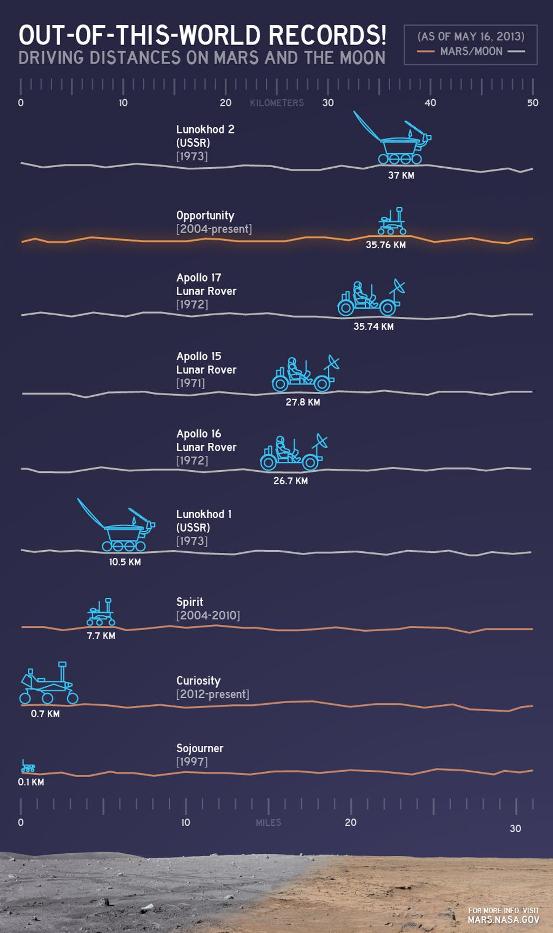
In May, NASA sent its rover from one studied mountain to another, much higher and more interesting. Between them, two kilometers, and, it seemed, still a little bit, like a lunar Soviet old man, stalled forty years ago, will give way to his Martian rival.
But Opportunity passed the cherished 37 km and ... silence. Neither the cheering parades in Washington, nor the boots knocking with annoyance on the tribune of the chairmen of the Politburo of the Central Committee of the CPSU.
And the secret of such silence from NASA is in the ninth wheel.
')
Everyone seems to know that the Opportunity has six wheels, while the Lunokhod has eight. But technically, the Lunokhod's had nine wheels. Ninth is a thin odometer roller that rolled along the surface of the moon and measured the distance traveled.

Official figures, published at the end of the scientific mission of Lunokhod-2, and for a long time wandering from scholarly works to textbooks, and from textbooks to Wikipedia, are based on the readings of this odometer. But the fact is that the movie was raised when Lunokhod-2 was moving backwards. The video did not convey an objective distance when the device was maneuvering, and in itself could slip on too loose soil.

As a result, the most objective means of determining its path could only be direct observation of traces on the lunar surface. Fortunately, today, scientists, and indeed any of us, have this opportunity thanks to the LRO spacecraft. His high-resolution LROC camera is second only to the HiRise camera of its Martian fellow MRO. But due to the orbit, several times lower, LROC is capable of transmitting virtually similar in detail images: in exceptional cases, up to 20 cm per pixel, but in the basic mode of operation - 50 cm per pixel. This is quite enough to detect on the natural satellite of the Earth Luna-21, which delivered Lunokhod-2 to the surface,
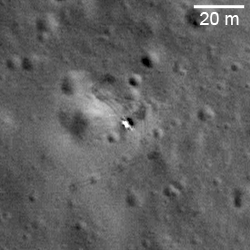
and, in fact, the nine-wheeled vehicle itself. True for him, the LRO dropped by half and removed 30 cm per pixel with detail:

Full size.
Find Lunokhod-2 yourself .
The discovery of Lunokhod-2 in the LROC photographs is no less exciting than that of Mars-3 : they first found it, but not that, then they looked at it and found it, and then they shone it with a laser and received a response from the optical corner reflectors.
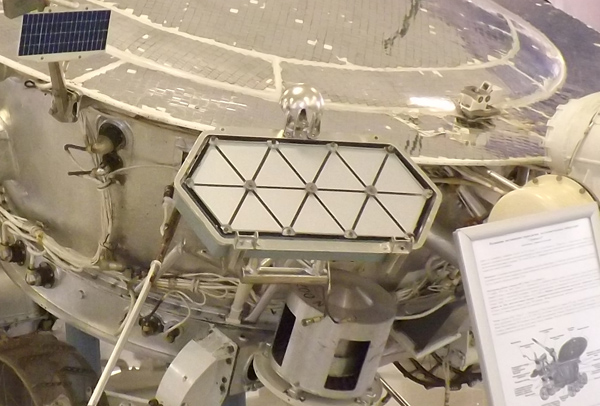
Russian scientists of Moscow State University of Geodesy and Cartography (MIIGAiK) carefully traced the entire route of Lunokhod-2 and determined its mileage of 42.2 kilometers. That is, due to the imperfect means of determining the distance traveled, more than 5 kilometers were missed. The exact figures up to a meter and now it is difficult to call.
Methods for measuring the distance traveled by the Mars rovers are fundamentally different. They use a complex system for calculating mileage, which includes a three-axis accelerometer and a three-axis level sensor.

The readings of these sensors are taken into account when calculating mileage based on wheel speeds. But even so easy to make mistakes due to slippage. Opportunity had plenty of them forever:
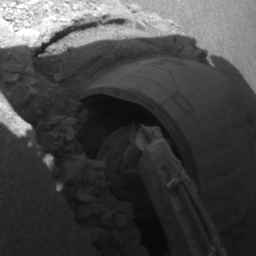
The main means for calculating the mileage of rovers, called VisOd: visual odometry. If you look at the pictures of their tracks, you can notice the heterogeneity of the trace left by the protector. Straight notches that differ from the main pattern - these are the markers for visual odometry.

The same principle is used in Curiosity. And the program considers mileage, but its indications can be periodically monitored manually. Among other things, Curiosity marks its mark with Morse code “JPL”, so its mileage can be counted in meters, feet and in jeeps. (Read more about Spirit mileage calculation )

Let's return to the Lunokhod-2.
For some, a new result, and the primacy of the domestic product in the interplanetary rally, can be a cause for pride. But we must remember that the lunar rovers and rovers were created primarily for the study of foreign bodies, and not for cheating odometers.
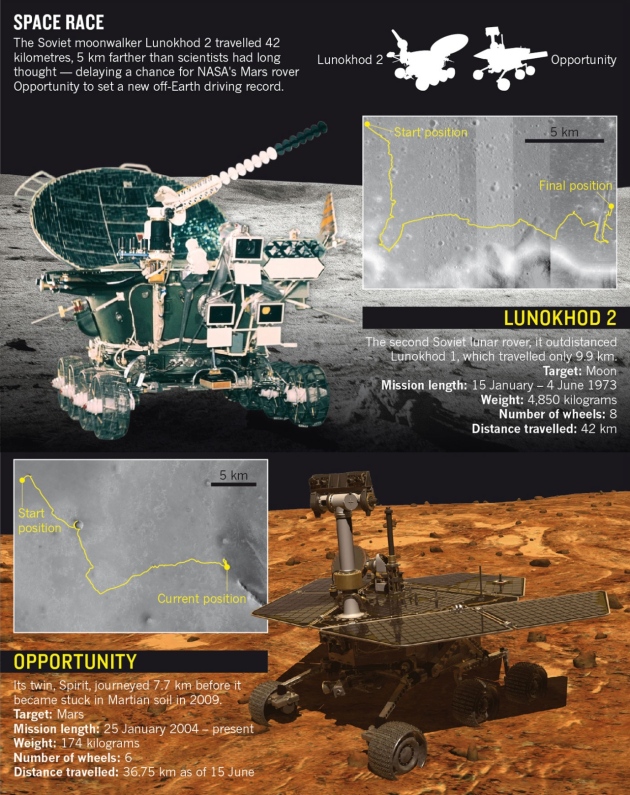
The problem is that the party leadership of the USSR looked only at odometers. The ideological machine, which operated on the notions of “catch up and overtake”, turned out to be incapable of the concepts of “learn and re-study”. Professor Alexander Bazilevsky of GEOKHI RAS, who helped in the search for Lunokhod-2 and Mars-3, described the events as follows: “As soon as Lunokhod ran across some interesting stone and geologists asked to stop, in order to investigate it in more detail, the management declared:“ This is a lunar rover , not lunostop. Only forward!"
Rovers are controlled by geologists. This explains that Curiosity, worked twice as long as Lunokhod-2, but drove almost fifty times less. Yes, and rally success Opportunity - is the result of his research activities. Approximately half of the total mileage, he overcame only crossing uninteresting spaces, which have already been well studied.
In the museum of the NPO. S.A Lavochkina is Lunokhod-3. This is not a model, but a real device, which took into account all the “childhood diseases” of its predecessors, had turning stereo cameras, not photometers, had a full range of research devices, passed all tests and was ready to conquer the lunar spaces.

But the party has already played enough in the "lunar tractor", so the "Russian Curioisty" forever froze on the Luna-25 ramp in the hall, where due to access restrictions of the regime object only a few visitors can get.
I express my gratitude to the leadership of the NGO. S.A. Lavochkin for the opportunity to visit this small, but interesting, for a fan of robotic space, a museum.
And so, as if in the old “good” times of the Cold War and the space race, two nations, the United States and the Soviet Union, entered into a tough struggle for leadership positions.

In May, NASA sent its rover from one studied mountain to another, much higher and more interesting. Between them, two kilometers, and, it seemed, still a little bit, like a lunar Soviet old man, stalled forty years ago, will give way to his Martian rival.
But Opportunity passed the cherished 37 km and ... silence. Neither the cheering parades in Washington, nor the boots knocking with annoyance on the tribune of the chairmen of the Politburo of the Central Committee of the CPSU.
And the secret of such silence from NASA is in the ninth wheel.
')
Everyone seems to know that the Opportunity has six wheels, while the Lunokhod has eight. But technically, the Lunokhod's had nine wheels. Ninth is a thin odometer roller that rolled along the surface of the moon and measured the distance traveled.

Official figures, published at the end of the scientific mission of Lunokhod-2, and for a long time wandering from scholarly works to textbooks, and from textbooks to Wikipedia, are based on the readings of this odometer. But the fact is that the movie was raised when Lunokhod-2 was moving backwards. The video did not convey an objective distance when the device was maneuvering, and in itself could slip on too loose soil.

As a result, the most objective means of determining its path could only be direct observation of traces on the lunar surface. Fortunately, today, scientists, and indeed any of us, have this opportunity thanks to the LRO spacecraft. His high-resolution LROC camera is second only to the HiRise camera of its Martian fellow MRO. But due to the orbit, several times lower, LROC is capable of transmitting virtually similar in detail images: in exceptional cases, up to 20 cm per pixel, but in the basic mode of operation - 50 cm per pixel. This is quite enough to detect on the natural satellite of the Earth Luna-21, which delivered Lunokhod-2 to the surface,

and, in fact, the nine-wheeled vehicle itself. True for him, the LRO dropped by half and removed 30 cm per pixel with detail:

Full size.
Find Lunokhod-2 yourself .
The discovery of Lunokhod-2 in the LROC photographs is no less exciting than that of Mars-3 : they first found it, but not that, then they looked at it and found it, and then they shone it with a laser and received a response from the optical corner reflectors.

Russian scientists of Moscow State University of Geodesy and Cartography (MIIGAiK) carefully traced the entire route of Lunokhod-2 and determined its mileage of 42.2 kilometers. That is, due to the imperfect means of determining the distance traveled, more than 5 kilometers were missed. The exact figures up to a meter and now it is difficult to call.
Methods for measuring the distance traveled by the Mars rovers are fundamentally different. They use a complex system for calculating mileage, which includes a three-axis accelerometer and a three-axis level sensor.

The readings of these sensors are taken into account when calculating mileage based on wheel speeds. But even so easy to make mistakes due to slippage. Opportunity had plenty of them forever:

The main means for calculating the mileage of rovers, called VisOd: visual odometry. If you look at the pictures of their tracks, you can notice the heterogeneity of the trace left by the protector. Straight notches that differ from the main pattern - these are the markers for visual odometry.

The same principle is used in Curiosity. And the program considers mileage, but its indications can be periodically monitored manually. Among other things, Curiosity marks its mark with Morse code “JPL”, so its mileage can be counted in meters, feet and in jeeps. (Read more about Spirit mileage calculation )

Let's return to the Lunokhod-2.
For some, a new result, and the primacy of the domestic product in the interplanetary rally, can be a cause for pride. But we must remember that the lunar rovers and rovers were created primarily for the study of foreign bodies, and not for cheating odometers.

The problem is that the party leadership of the USSR looked only at odometers. The ideological machine, which operated on the notions of “catch up and overtake”, turned out to be incapable of the concepts of “learn and re-study”. Professor Alexander Bazilevsky of GEOKHI RAS, who helped in the search for Lunokhod-2 and Mars-3, described the events as follows: “As soon as Lunokhod ran across some interesting stone and geologists asked to stop, in order to investigate it in more detail, the management declared:“ This is a lunar rover , not lunostop. Only forward!"
Rovers are controlled by geologists. This explains that Curiosity, worked twice as long as Lunokhod-2, but drove almost fifty times less. Yes, and rally success Opportunity - is the result of his research activities. Approximately half of the total mileage, he overcame only crossing uninteresting spaces, which have already been well studied.
In the museum of the NPO. S.A Lavochkina is Lunokhod-3. This is not a model, but a real device, which took into account all the “childhood diseases” of its predecessors, had turning stereo cameras, not photometers, had a full range of research devices, passed all tests and was ready to conquer the lunar spaces.

But the party has already played enough in the "lunar tractor", so the "Russian Curioisty" forever froze on the Luna-25 ramp in the hall, where due to access restrictions of the regime object only a few visitors can get.
I express my gratitude to the leadership of the NGO. S.A. Lavochkin for the opportunity to visit this small, but interesting, for a fan of robotic space, a museum.
Source: https://habr.com/ru/post/187286/
All Articles